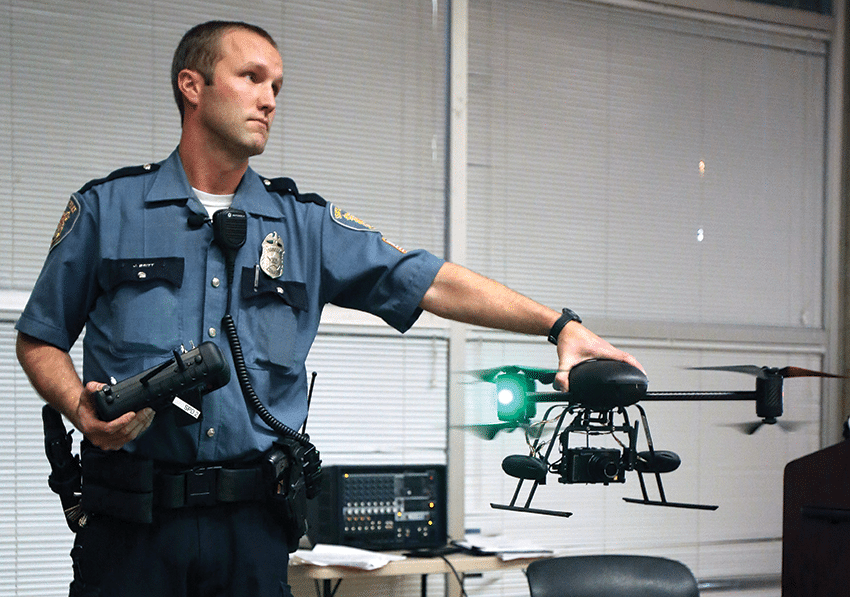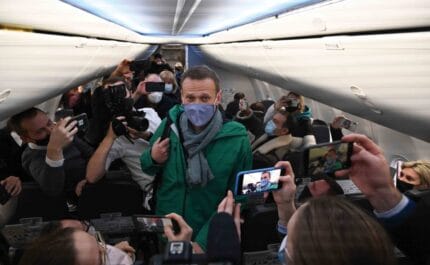The power behind the drone
Obama's revelation last week that the US had accidentally killed two al-Qaeda hostages in a drone strike added to the controversy over the administration's drone programme. Back in 2013, we talked to Missy Cummings, the woman charged with creating the US navy's first search-and-rescue unmanned aerial vehicle. Here's why she thinks drones can be a global force for good

Photo: Mark Johnson
23rd May 2013 (Taken from: #11)
Drones get a bad press. If they’re not being portrayed as killing machines they’re evil spybots, silently patrolling our skies, threatening our civil liberties, or papping celebrities on the beach. For many, there’s something intrinsically ominous about unmanned flying objects. But a world filled with drones may be far less dystopian than we think, which is why Missy Cummings, one of the world’s leading experts on UAV (unmanned aerial vehicle) technology, is comfortable with accusations that she’s working on the dark side.
“I love it when people call me evil, it’s the best compliment ever,” she says, talking to me in a coffee shop in Arlington, just outside Washington DC. “It’s hard to get people to take women seriously and it takes a lot to be described in such vitriolic terms.” Cummings is unquestionably someone to be taken seriously. She was one of the US navy’s first handful of female fighter pilots, a job she left to study for a PhD in systems engineering. She’s now the director of the Massachusetts Institute of Technology’s Humans and Automation Laboratory. Her Twitter byline succinctly lists her achievements: “Professor, pilot, mom”.
I love it when people call me evil, it’s the best compliment ever”
She makes her points with assurance; she is, after all, a practised public speaker who has recently appeared on US satirical programmes ‘The Daily Show’ and ‘The Colbert Report’ to talk about what she believes is the endless scaremongering that drowns out sensible discussion of the role of UAVs. But she hasn’t always been this confident. She was “insecure” and “neurotic” when she became one of the only women in a male-dominated naval academy.

Missy Cummings with her fellow US navy fighter pilots. Photo: courtesy of Missing Cummings
When the Combat Exclusion Act was repealed in 1993 and she began flying F/A-18 Hornet fighter planes, her male colleagues’ behaviour became resentful and misogynistic, a difficult period documented in her memoir, ‘Hornet’s Nest’. “Two things really helped me gain confidence,” she recalls. “Landing on an aircraft carrier by myself and getting my graduate degree in engineering.”
After leaving the military in 1999, she was determined to learn more about the aviation technology that had given her some of the most thrilling experiences of her life, but which had also been involved in the death of some of her friends. If, she thought, we’ve got the technology to build pilotless planes that can do a more efficient and accurate job than human beings, then why are we still risking our pilots’ lives?
At MIT’s Humans and Automation Laboratory, she focuses on how humans interact with advanced automated technology – and there is still a large degree of interaction. A pilotless plane needs a human being controlling it because there are still decisions – in a military context, often difficult ethical decisions – that can’t be made by robots alone.

An unmanned helicopter used to survey radiation levels in the no-fly zone over the Fukushima Nuclear Power Station in Japan, October 2012. Photo: AP/Press Association Images
Cummings is currently on leave from her MIT post. Several years after swapping piloting for the more sedate world of academia, she’s back working with the US Navy, albeit on a temporary basis and in a very different capacity. The Intergovernmental Personnel Act allows the US government to reach into the country’s universities for expertise when they don’t have the right people in house – and nobody is better qualified than Cummings on the topic of UAVs, which is why she’s working on a new project, the development of a rescue drone for the navy. Under her supervision, two companies are competing to build an unmanned aircraft that will be able to pick up injured servicemen and women from battle zones. “I’m working on a technology that actually saves lives instead of taking them, which I feel good about,” she says.
Not everybody in the military is excited by the possibility of rescue drones, says Cummings. She’s spoken to many in the armed forces who wouldn’t be comfortable riding in a robot helicopter, but their view changes when she asks them to imagine a scenario in which they’ve just taken a bullet to the chest and the nearest trauma unit is five minutes away by air or five hours by car. “When you present people with the right kind of circumstances they will change, they are very utilitarian,” she says. If their lives depend on it, they’ll take the drone.
I’m working on a technology that actually saves lives instead of taking them, which I feel good about”
Skepticism of UAVs extends well beyond the military, and Cummings is regularly embroiled in arguments about her work. People find robots scary, but this isn’t ‘Terminator’ – there are still humans at the controls. The first problem, she says, is the word “drone”. “UAV is the term people in the field prefer because ‘drone’ connotes a kind of stupidity, as if it’s a drone bee, just a simple device gathering information.”
A bigger problem is what she believes is a lack of nuance in the media’s portrayal of UAVs. “As a person who is working on other applications for drones, I resent the media for pushing the idea that they are only good as spy agents,” she says. “The flying camera is probably the least efficient use of a drone. It takes a lot of resources to actually follow someone with a mobile thing that is flying around, and we only do that for very special, very bad people. The idea that we’re just watching people at random, able to follow anybody we want, is hilarious and it shows how people buy into the fear.”
In June 2013, the head of the FBI, Robert Mueller, admitted that the organisation was experimenting with drone surveillance in a “very minimal way”, but Cummings says it’s not something Americans should worry about – they should go to London, whose ubiquitous closed-circuit television cameras make it the most spied-upon city in the world. “Do you hear them complain about it?” she asks. “Are there ridiculous videos violating people’s privacy showing up on YouTube? No, it’s a culture which has accepted some loss of privacy and some loss of personal autonomy for the greater good. Europeans understand the need to be able to live and work together and be able to protect their safety.”

Seattle police’s drone programme was suspended in February 2013 after protests from local residents. Photo: Colin Diltz/AP/Press Association Images
She complains that the public is being kept in the dark over UAVs’ non-military, non-intelligence functions. In a situation like the Haiti earthquake, for example, where the weather makes it too dangerous for piloted planes, drones could drop off life-saving medical supplies. In countries with sparsely populated areas and remote towns, they could potentially assist in the cost-effective delivery of food and other goods, and could work as remote-controlled air ambulances to rescue people stranded in places far from hospitals.
In May, the Royal Canadian Mounted Police used a drone with an infrared camera to find a man who had been in a car crash in a isolated part of the country. It was only a small drone, and a regular manned helicopter flew in to save his life, but the technology is there to do everything in one go. In New Zealand, drones are being used by the police to help catch criminals (“when a socialist country like New Zealand starts using UAVs to do criminal enforcement, I think that is awesome,” says Cummings).
The German railway operator, Deutsche Bahn, wants to use mini drones to catch vandals who graffiti its trains, and the Australian wing of Sea Shepherd, a radical anti-whaling campaign group, has purchased drones to assist in their surveillance of Japanese whaling ships. UAVs, it seems, are the future – and not just for the military.
“When you can send your packages for $4 from coast to coast, who’s not going to sign up for that?” asks Cummings, who is confident that the public will warm to UAVs when they begin to better understand their non-military uses. One reason why she is struggling to sell her vision of a more automated future is because we’re wary of humans becoming increasingly marginalised – it means people lose jobs, and we miss out on human interaction. But she believes it’s something that we will adjust to. “Originally people were creeped out by ATMs,” Cummings says. “It was weird to get your money from this machine without talking to a human, but now we all do it. I can’t wait until we’re all in automated cars – I hate driving!”

The US Navy’s first drone to be launched from an aircraft carrier in May 2013. Photo: Steve Helber/AP/Press Association Images
Driverless trains are increasingly the norm, commercial flights are already flying themselves for the most part, and Cummings predicts pilotless commercial passenger planes in the not-too-distant future.
Ultimately, she believes, the question is similar to the one she posed after leaving the military – why have a fallible human pilot when there are better options? Plenty of pilots fly while hungover, tired or “bored and playing on their iPhone”, she says, and helicopter pilots flying in stormy weather simply can’t make decisions fast enough to keep their vehicles balanced.
Although the US spends the most money on drone technology, it’s still underperforming, says Cummings. Israel is more innovative in the field, and Australia, a country with no shortage of unpopulated airspace and land, is a leader in robotic technology research. She sounds more than a little envious when she speaks of the progress in the European Union: “We joke about how the EU can never get consensus on anything, but the one thing they can agree on better than the US is UAV airspace policy. I think, Come on people, we’re getting our butts kicked by countries that normally can’t agree on anything – what does that say about us?”
Yes we still kill the wrong people and yes, we still kill people. But we are making a lot fewer mistakes than before”
The UK has also been making progress. The Ministry of Defence has been testing its drones since 2004 on an airfield near Aberporth in west Wales, the only site in Europe where UAVs can fly alongside normal manned aircraft. More than 1,000 UAV flights have taken off from this base, including surveillance drones sent to Afghanistan. In May 2013, the MoD told the Guardian of its intention to increase these programmes significantly. They’re finding that unmanned and manned aircraft can easily co-exist in airspace. And it’s only a matter of time before the former outnumber the latter.
“I feel a sense of responsibility to make sure people understand the science,” says Cummings. “I am not a policy maker, but people need to understand the technical issues so they can make policy. Believe me, lots of really bad policies are made despite my recommendations, despite what I have to say. People tend to make decisions for emotional reasons, even in government agencies.”

On 23rd April 2015, president Barack Obama took responsibility for the deaths of two al-Qaeda hostages, one US and one Italian, who had been killed in a January drone strike in Pakistan. Photo: Pablo Martinez Monsivais/AP/Press Association Images
On 23rd April 2015, president Barack Obama took responsibility for the killing of two al-Qaeda hostages, one US and one Italian, in a January drone strike in Pakistan. Photo: Pablo Martinez Monsivais/AP/Press Association Images
While Cummings’ current project of creating a life-saving search and rescue drone is a humanitarian one, and while she’s a powerful supporter of humanitarian UAV technology, she is still a vocal supporter of military attack drones, of the sort deployed by the US in Pakistan. “I am a big proponent of robotic technologies that pull people out of the field and take the stress out of the combat so their decision making is much more calm and more well informed,” she says. “Yes we still kill the wrong people and yes, we still kill people. But we are making a lot fewer mistakes than we were when I was [a fighter pilot] and certainly a few years before that. So by having these more advanced forms of warfare we are actually reducing the burden that everyone has to shoulder.”
As I leave the interview, I check my phone. A news report has come through saying that the British navy has just sent a squad of underwater drones to the Persian Gulf to help deter mine-laying by Iranian ships. While we may not feel as excited about the potential of UAVs as Cummings – or as clear about the morality of their use – we are all part of her world now.
Slow Journalism in your inbox, plus infographics, offers and more: sign up for the free DG newsletter. Sign me up
Thanks for signing up.








